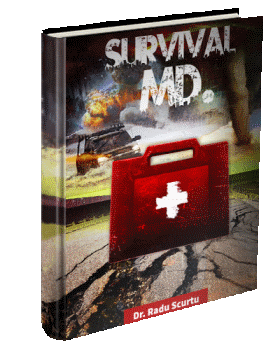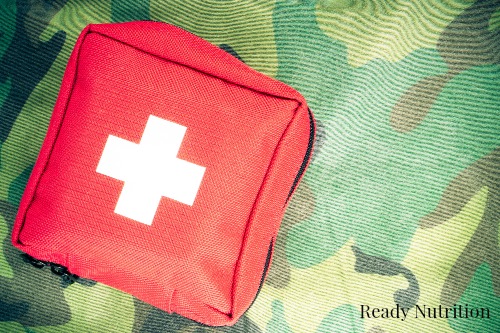In this introduction we are going to go over some medical basics: some courses you may wish to take and a brief introduction to a primary survey. In part 2 we are going to cover some materials you will need for an aid bag and some basic medical supplies to equip it. We’re also going to go over a few things it would behoove you to learn to prepare you for your first experience, be it in the wilderness or if you’re out for a hike in the park, or if some kind of long-term disaster has occurred.
Firstly we must mention that all of the information in this article is strictly for informational purposes only. The information is not meant to diagnose, treat, prescribe, or recommend any action or procedure detailed. Such actions can only be taken by a licensed, certified physician. Consult with your family doctor prior to undertaking any and all actions outlined in this article.
Trauma medicine, loosely phrased, is simply the application of first aid and treatment that varies in complexity based on the degree of accident or injury. Trauma medicine is life over limb, and to follow the motto of the Special Forces Medic should be primary in your mind: Primum Non Nocere, Latin for “First, I shall do no Harm.” If you can’t do it and don’t know how to do it, don’t make the attempt…unless a life is at stake and there is no other alternative.
There are some basics that you will need to obtain for yourself in the form of information prior to putting together a trauma kit. All too often, everyone stocks up on supplies, stocks up on equipment, and builds up a storehouse of materials. This is all fine and well; however, you must know how to use the equipment. Such a principle does not apply only to Trauma Medicine and First Aid, but to all facets of your prepping journey.
I highly recommend the following to take either as a course of study or to study personally on your own:
- Anatomy and Physiology Course: such an A&P course can do nothing but benefit you throughout your life. In order to help someone you need to know about the anatomy and functions of people.
- CPR Course: will provide you with basic life support techniques that will give you fundamental knowledge to help you sustain life in an emergency.
- ACLS Course: Advanced Cardiac Life Support; this course teaches you about the arrhythmias and related problems of heart attacks and heart conditions, along with teaching you about EKG/ECG readings and how to differentiate the various conditions from a strip.
There are certainly other courses that could be mentioned, but these basic three
would give you a good head start. Such courses can be found in community colleges, local county extension offices, local fire departments, and with veterans groups, along with other civic clubs and organizations. Knowledge is key, and it is the fundamental key to success in this area of endeavors. The list is not exhaustive, nor are you finished should you complete these three: your learning is a continuous process.
The M-5 Combat Aid bag was the standard “tote” for all of the tools, equipment, and supplies needed for a medic. We will cover what is needed for a good, standard aid bag in the next installment. What we will list now are subjects that it would behoove you to study. As I mentioned, knowledge is key. Here they are:
- Bandaging and splinting
- IV’s and fluid replacement therapy

- Wound suturing and vessel ligation
- Burns (rule of 9’s and supportive care)
- Primary and Secondary survey
- Taking a correct patient history
- Antibiotics and their uses
- Field Sanitation and hygiene (this is the Medic’s job)
- Tension pneumothorax & hemothorax
- Drowning and water injuries
Once again, this list is far from exhaustive. Trauma medicine is involved, and one must have their basics down pat before attempting any of the measures. Your primary and secondary surveys, along with patient history are critical for your task with trauma. When you (as the first-aid responder) say, “Hey, buddy are you alright?” and he groans at you, looks in your direction, and yells, “I’m really hurt bad!” Guess what? He’s yelling at you; therefore, he has an airway that is probably not obstructed, and his speaking to you means he’s able to breathe, at least for now.
A-B-C’s must be followed: Airway, Breathing, and Circulation. Those are your priorities for your patient, in that order, the bare bones (no pun intended!) beginning of the primary survey.
Airway: Does the patient have a clear airway that allows for air exchange? Is he gurgling or gagging? You must visually inspect while protecting the C-spine (cervical spine) that should immediately be immobilized for the patient’s safety. If the airway is not cleared it must be cleared (if patient is unconscious, an oropharyngeal airway may need to be inserted).
Breathing: Is he breathing on his own? If not, he’s probably unconscious in which case you must perform CPR. The brain can only survive about 6 minutes without oxygen.
Circulation: Is he bleeding? Does he have a pulse? Is it strong and regular, weak and thready? What is the characterization of the pulse?
A good saying for you to remember: “Head to toe, treat as you go.” This will enable you to follow the A-B-C’s all the way down and utilize your primary survey to obtain a proper patient assessment. History of the patient is the key here. Ask the patient what happened to him. Many times I have seen medics overlook that step and it would have saved them a lot of time and energy. Unevenly sized pupils are often a sign of head trauma, such as a concussion. I know of a man who was born that way with no ill effects. The condition is known as anisocoria. In such a case, knowing the facts of the patient’s history can rule out “going fishing,” i.e.-looking for a problem that doesn’t exist.
The first thing you must do is assess the patient, and the assessment is continual. I have seen a patient go from fairly healthy in appearance to almost a flatline with no pulse or breathing in under a minute. Keep this in mind: patient assessment is continual. Never turn away from the patient! All it takes is your eyes off of him or her for even a few seconds and something can happen that will take the patient away from you.
Such is the importance of this module/part to trauma: your mindset. You must first do no harm, and you must arm yourself with knowledge. We have mentioned a few things to get you started and next time we’ll cover the equipment you need and get ready to cover certain procedures for different first aid actions. Have a great day!
JJ
OTHER USEFUL RESURCES!
Mega Drought USA:(Discover The Amazing Device That Turns Air Into Water)-DIY
Survive The End Days (Biggest Cover Up Of Our President)
Survival MD (Best Post SHTF Medical Survival Guide Ever)
Blackout USA (EMP survival and preparedness guide)
Bullet Proof Home (A Prepper’s Guide in Safeguarding a Home )
Backyard Innovator (All Year Round Source Of Fresh Meat,Vegetables And Clean Drinking Water)-DIY
Conquering the coming collapse (Financial advice and preparedness )
Liberty Generator (Easy DIY to build your own off-grid free energy device)
Backyard Liberty (Easy and cheap DIY Aquaponic system to grow your organic and living food bank)
Family Self Defense (Best Self Defense Strategies For You And Your Family)
Sold Out After Crisis (Best 37 Items To Hoard For A Long Term Crisis)
Jeremiah Johnson is the Nom de plume of a retired Green Beret of the United States Army Special Forces (Airborne). Mr. Johnson was a Special Forces Medic, EMT and ACLS-certified, with comprehensive training in wilderness survival, rescue, and patient-extraction. He is a Certified Master Herbalist and a graduate of the Global College of Natural Medicine of Santa Ana, CA. A graduate of the U.S. Army’s survival course of SERE school (Survival Evasion Resistance Escape), Mr. Johnson also successfully completed the Montana Master Food Preserver Course for home-canning, smoking, and dehydrating foods.
Mr. Johnson dries and tinctures a wide variety of medicinal herbs taken by wild crafting and cultivation, in addition to preserving and canning his own food. An expert in land navigation, survival, mountaineering, and parachuting as trained by the United States Army, Mr. Johnson is an ardent advocate for preparedness, self-sufficiency, and long-term disaster sustainability for families. He and his wife survived Hurricane Katrina and its aftermath. Cross-trained as a Special Forces Engineer, he is an expert in supply, logistics, transport, and long-term storage of perishable materials, having incorporated many of these techniques plus some unique innovations in his own homestead.
Mr. Johnson brings practical, tested experience firmly rooted in formal education to his writings and to our team. He and his wife live in a cabin in the mountains of Western Montana with their three cats.
This information has been made available by Ready Nutrition


